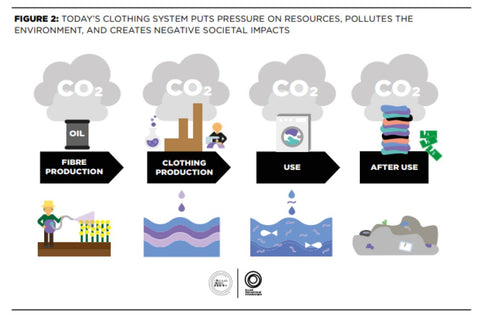Fast Fashion - How it negatively impacts the environment?
The e-commerce ads with new trends and mouth-watering discounts are very tempting, aren’t they? Don’t you get the urge to buy at least a few clothes from H&M or Zara? Even after the hordes of clothes in your wardrobe, don’t these ads make you feel that you don’t have enough clothes? If yes, you are prey to “Fast Fashion”. And frankly, we too are guilty of being its victim. Let’s talk about the elephant in our closet – Fast Fashion.
In simple words, Fast Fashion refers to bringing latest fashion styles to the public at an affordable price. This can be achieved by rapid production and low quality materials. In short, Fast Fashion is like Fast Food – Tasty, Cheap but Unhealthy. Why unhealthy? You will find out later ahead. Although we have covered only garment industry in this article, Fast fashion also extends to footwear, bags, accessories, etc.
Origin
Fast Fashion traces its roots to around 1960s where Zara created supply chains enabling them to replicate new fashion trends within couple of weeks. Till then, the fashion industry used to design clothes only for four seasons of the year. In addition to Zara, brands like H&M, Forever 21 were instrumental in the growth of Fast Fashion. Brands like Pantaloons, Fashion at Big Bazaar, AJIO, Myntra, Reliance Trends, etc are torchbearers of Fast Fashion in India.
What do the Stats say?
From 2000 to 2015, clothing sales have doubled which translates into a yearly growth of 4.7%[1]. To put this in context, in the same period, World economy grew by only 2.7% [2].

Clothing utilization, measured by the number of times an item is worn, has reduced from 200 in 2002 to around 128 times in 2016 i.e. a reduction of 36%[1]. This is mainly led by the surge in consumerism among the Chinese. This utilization would have most likely fallen further post 2015 considering other Emerging countries like India are becoming increasingly aspirational & consumption driven. In short, our clothing consumption is rising at an alarming rate.
But what is wrong with Fast Fashion?
Prima facie, why would Fast Fashion be harmful? It looks like a win-win for all. The consumers win because they can buy fresh designs inexpensively. And the producers win because they can increase their turnover & hence their profits. It also employs a staggering 7.5 Crs people in the supply chain![3] But doesn’t this look too good to be true? Like we said earlier, Fast Food is cheap, tasty but it is also very Unhealthy. The same with Fast Fashion. So, who is it Unhealthy for? The labourers manufacturing garments & the environment. Other than that, synthetic clothing is also not good for our skin. A garment worker’s health is constantly at risk due to long hours of work at meagre pay, exposure to harmful dyes and chemicals and shabby working conditions. The collapse of the Rana Plaza factory complex in Bangladesh in Apr’13 killing 1,132 people and injuring many others is an example highlighting their poor work conditions [4]. There have been many such incidences of such sufferings. Now coming to environment. At all stages of cloth production, from production of fibre to the manufacturing of the final product, environment is impacted. The environment also gets impacted during usage and disposal of garments. The textile industry uses significant amounts of resources – Water, Land, electricity, chemicals throughout its value chain. It also releases huge quantities poisonous chemicals and dyes back into land and water, polluting them. The environment is indeed paying a huge cost for our insatiable hunger for clothing.

At the end of the blog, we have listed a few but very pertinent facts about the impact to environment during the manufacturing process.
What can consumers do?
With the advent of E-commerce, supply chains and logistics have been developed to make it simple and super convenient for people to consume. But the logistics for people to dispose and recycle are not in place. And till the time these develop, our clothes will continue to be landfilled or incinerated. There are few upcoming ideas, which if successful, can reduce the number of clothes we buy. Services like Short term Rental clothing, Garment Swapping and Rental Subscriptions are few of them. Short term rental service, for example, can be brilliant for party wear. It can also be useful for a tourist who wants winter clothing for a very short term.But in order for these ideas to be successful, it will require a big mindset change among consumers. A lot of consumers may be sceptical about wearing used clothes. But mindset can be changed, as evidenced by Uber and Ola in the car rental space. The clothing space might be tougher, but we are hopeful.
But in the meanwhile, what can we as Consumers do – we can adopt #SlowFashion
We need to be more mindful and less impulsive while making purchasing decisions. The idea is not to stop consumption, but to consume with conscience. These few pointers maybe helpful in adopting Slow Fashion.
-
Fabric Selection Cotton, though biodegradable, is not the most eco-friendly due to it being water & pesticide intensive in its production. Polyester is worse considering its input is crude oil and hence is non-biodegradable. It is difficult to avoid clothing made of cotton, but we can try to minimize polyester consumption.There are alternative fabrics like Organic Cotton, Bamboo, Hemp, Linen, Lyocell, Modal that are available. These alternatives are not just environment friendly but also tend to be more comfortable and durable. Unfortunately, these fabrics are expensive as compared to traditional fabrics due to a lack of supply chain.
-
Conscious Purchases While planning to purchase clothes, we need to think consciously whether we actually require them. Though it is difficult to not be lured by the marketing campaigns to make us consume, we need to resist the urge. Also, less consumption of clothing means less consumption of packaging. “We have so much power to change the world by just being careful in what we buy” - Emma Watson (Actor, Model & Activist)
-
Durable Options While evaluating the choices at the time of purchase, in addition to the design and the cost, consider options which are more durable. Look at factors like thread count and type of fabric. Durable clothes might seem expensive but if seen on a Cost per wear basis, they would end up much cheaper. For example, If you buy a garment worth Rs. 1000 and wear it only 2 times before discarding, then the cost per wear is Rs. 500. Whereas, if you buy a garment worth Rs. 2000 but wear it 8 times, the cost per wear is Rs. 250. If low quality materials are used in garments, cost per wear would definitely end up higher.
-
Spread the Word Fast Fashion is as important as any issue that we discuss. Awareness is a catalyst for change and more people need to become aware that our consumption patterns have severe ramifications. If we demand a change, slowly but surely, will we get one.
Remember, “We rent the environment from the future and not inherit it from the past”.
Appendix
Below are some facts and figures to highlight the extent of resource utilization and the pollution created in various stages of textile production, its usage & disposal. These examples are by no means exhaustive.
Fibre Production
Cotton needs a lot of water to grow. 1 Cotton T-shirt requires 2700 Litres of Water to produce which translates to 2.5 years of drinking water for 1 person[5]. Cotton is usually grown in hot regions where water scarcity is already an issue. Cotton production just compounds that.
Even though, globally, Cotton is grown in around 2.5% of arable land, but 16% pesticides are used for growing cotton. In India, 50% of all pesticides used are for cotton production[1].
Clothing Production
The production of 1 Kg of cotton garments uses up to 3 Kg of chemicals. For eg., to achieve crease-resistant ‘non-iron’ garments, clothing is often treated with formaldehyde – which has been classified as carcinogenic to humans by the International Agency for Research on Cancer, and is also linked to allergic contact dermatitis[1].
20% of industrial water pollution globally is attributable to the dyeing and treatment of textiles[1].
Usage
Microfibres are released from synthetic clothing items during every wash. These then mix in water and with aquatic life and get then consumed via drinking water and through seafood. Each year, 0.5 million tonnes of plastic microfibres – equivalent to more than 50 billion plastic bottles[1] – are estimated to be released into the ocean. And this number is just going to rise!
Disposal
Across industries, only 13% of the total textile material input is in some way recycled after clothing use [1]. The rest is either landfilled or incinerated.
References
1. Ellen MacArthur Foundation, A new textiles economy: Redesigning fashion’s future, (2017, http://www.ellenmacarthurfoundation.org/publications)
2. World Bank
4. International Labour Organization- https://www.ilo.org/global/topics/geip/WCMS_614394/lang--en/index.htm
5. World Research Institute - https://www.wri.org/blog/2017/07/apparel-industrys-environmental-impact-6-graphics
Subscribe to our newsletter
Promotions, new products and sales. Directly to your inbox.

